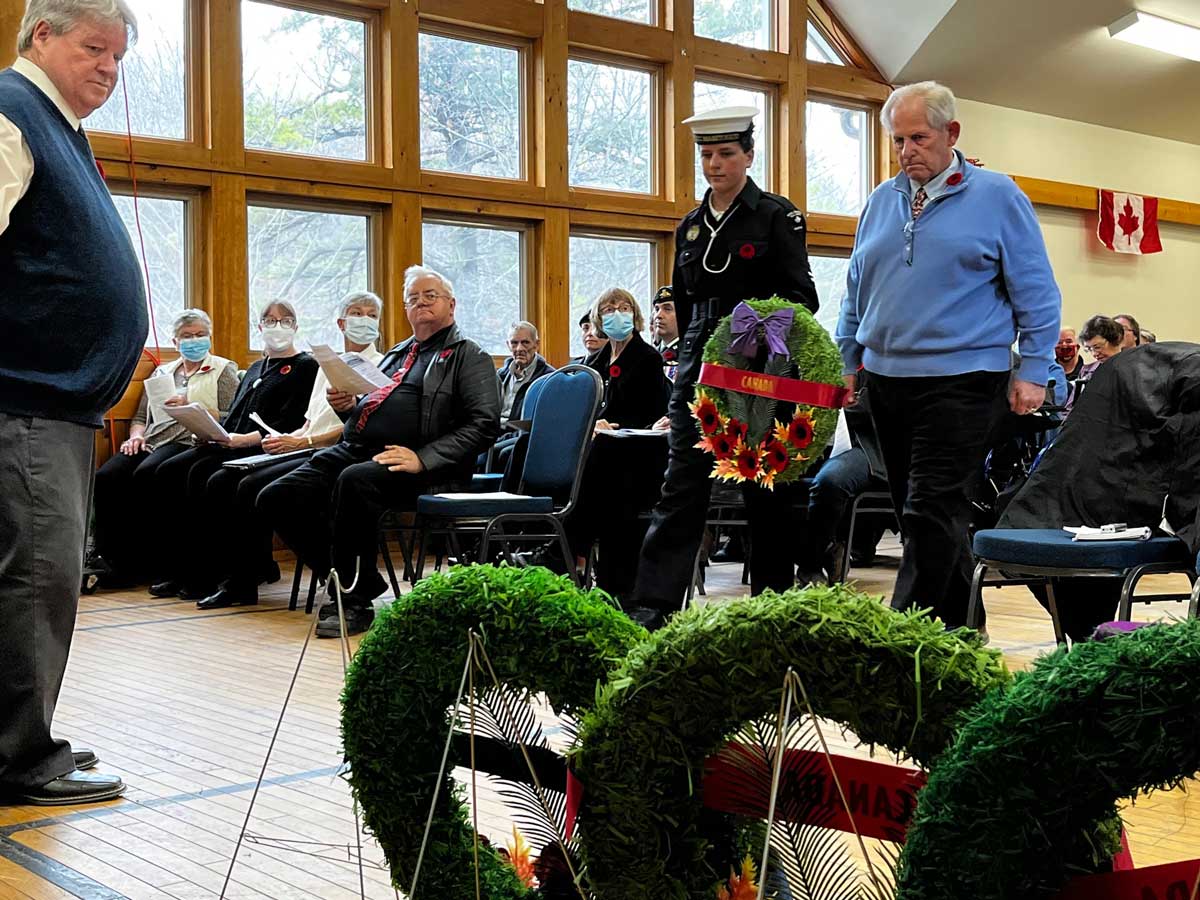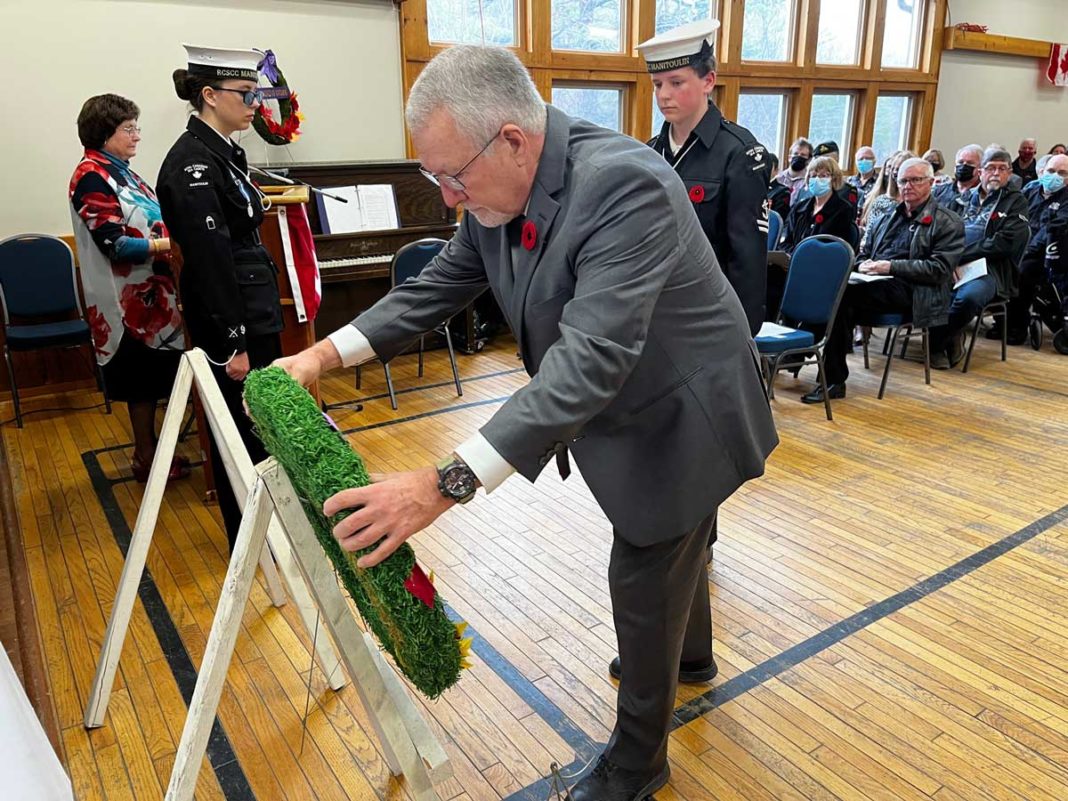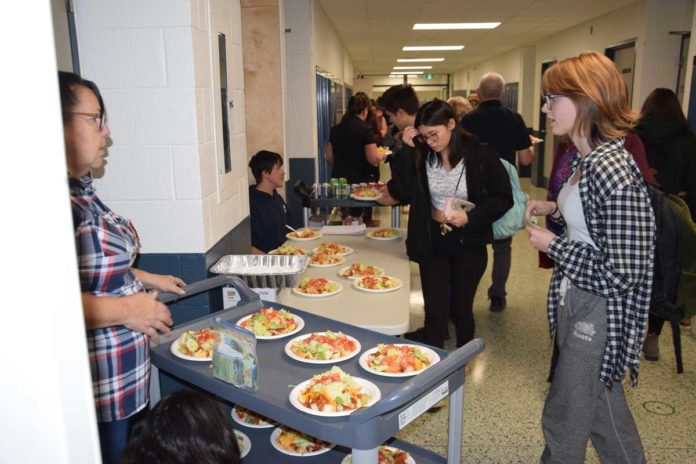KAGAWONG—The community gathered in person for a Remembrance Day service for the first time in two years, following a pandemic-related hiatus. Kagawong’s Cenotaph Board hosted the service on November 11, remembering and honouring all those who have served this country.
Dianne Fraser, a member of the Cenotaph Board, led the service. Special guests included Lt-Colonel Lesley Kerckhoff and Lt-Colonel Marc Langelier of the Canadian Armed forces and members of the 348 Royal Canadian Sea Cadet Corps Manitoulin. Choir members Mark Munro, Peter Gordon, Willa Wilson, Diane Larocque and Sandy Cook lent their voices to the hymn ‘O Valiant Hearts’ and other songs.
Ms. Fraser spoke about Canada and how it grew into its international peacekeeping role. “The first half of 20th century marked by many years of tragedy and destruction,” she said. “By 1945 the world had suffered through two devastating world wars. Many nations wanted to make sure that such wars would never happen again. So that year 50 countries, including Canada, joined together to form an international organization called the United Nations.”
The United Nations (UN) now has 193 members with the goal of working together to prevent future wars and help nations resolve conflicts peacefully. The organization faced an “alarming” crisis in 1956, with nations in the Middle East vying for control of the Suez Canal, an important trade route. With tensions high, Canadian diplomat Lester B. Pearson stepped in. Mr. Pearson was head of the Canadian delegation to the UN at that time. He came up with a plan to create a large international peacekeeping force, made up of forces from neutral countries, to stabilize the situation in the canal region while a settlement was worked out.
Peacekeeping has since become part of Canada’s national identity, and more than 125,000 Canadians have served in over 50 peacekeeping operations. Over the years peacekeeping operations have expanded to include a variety of other roles and duties such as rebuilding war torn places by assisting with the construction of schools, hospitals and roads; spreading democracy by supervising free elections; reclaiming dangerous landscapes by clearing land mines; and training law enforcement and police forces around the world.
In 1988 the Nobel Peace Prize was awarded to all UN peacekeepers, including Canadians, in recognition of their efforts to limit conflict and promote peace. Soon after that the Canadian government sponsored the creation of a peace monument in Ottawa and has introduced a peacekeeping service medal to honour Canadian peacekeepers for their bravery and commitment.
Ms. Fraser then led guests in a prayer for the fallen and remembered the 80th anniversary of the Dieppe Raid.
The Dieppe Raid, which occurred on August 19, 1942 in Northern France, saw 907 Canadians killed within 10 hours. Another 2,460 were wounded and 1,946 captured. “The bravery of that event is not forgotten during the laying of the wreaths,” said Ms. Fraser. Wreath layers were escorted to the front of the hall by members of the 348 Manitoulin Sea Cadets.
It wouldn’t be Remembrance Day without the reciting of ‘In Flanders Field’, which was recited by David Hillyard.
Rick Nelson spoke about the Cuban missile crisis of 1962, which brought the world to the brink of nuclear war. The story was partly a tale of a near-Armageddon moment and partly a tribute to the late Peter Fletcher, former chair of the Cenotaph Board.
“Our dearly departed former Kagawong Cenotaph chair Peter Fletcher was a cold war veteran, and he was enthusiastic when I once suggested telling a good old fashioned Cold War story at a future Remembrance Day service,” said Mr. Nelson. ‘Cold War’ refers to the NATO-Soviet conflicts between 1947 and 1991 that did not involve direct military action.
“Cold War vets can be humble about their service in the presence of World War II vets,” continued Mr. Nelson. “But I think a veteran from the Second World War might say the world didn’t blow itself up during the Cold War because vets like Peter Fletcher were standing guard to protect the peace.”
There’s no better Cold War story than the Cuban missile crisis, Mr. Nelson continued. Between October 16 and 28, 1962 the United States and the Soviet Union were “eyeball to eyeball in a military standoff over the installation of Soviet nuclear missiles in Cuba, posing a direct threat to North America, including Canada.”
It was all about the balance of power.
Life carried on as usual on Manitoulin Island, Mr. Nelson said. It was hit with an early snowstorm that October but it didn’t stop the locals from getting out and about. The Island was paying attention, however. At the Gore Bay high school, they prayed for peace over the public address system.

The 15 minutes Mr. Nelson had to speak only allowed him to scratch the surface of the crisis. “But 15 minutes, that’s about all the time it would take for a missile launched from Cuba to reach Manitoulin Island,” he said. Fortunately, Manitoulin Island was never a military target. The closest target to us might have been North Bay, the Canadian headquarters for NORAD.
“The bad news,” Mr. Nelson continued, “is the Island’s population may have died anyway, from radiation poisoning.” Prevailing winds could have carried radiation fallout to Manitoulin Island in only a matter of days.
In the end, President Kennedy cut a deal with the Soviets and World War III was avoided. It was a close call.
“Sixty years later, history is still giving up its secrets as to how close it really got,” Mr. Nelson said. “There’s only one way to describe how we survived October 1962: we got lucky.”
He concluded by saying, “We remember our Cold War Veterans and our post Cold War veterans who helped keep that peace, handed down to them by veterans of our greatest generation who gave us that peace. Thank you all and to the current members of the Canadian Armed Forces, thank YOU for your service as well.”
Following the service, Lt-Colonel Lesley Kerckhoff and Lt-Colonel Marc Langelier laid one final wreath outside at the Kagawong Cenotaph.





